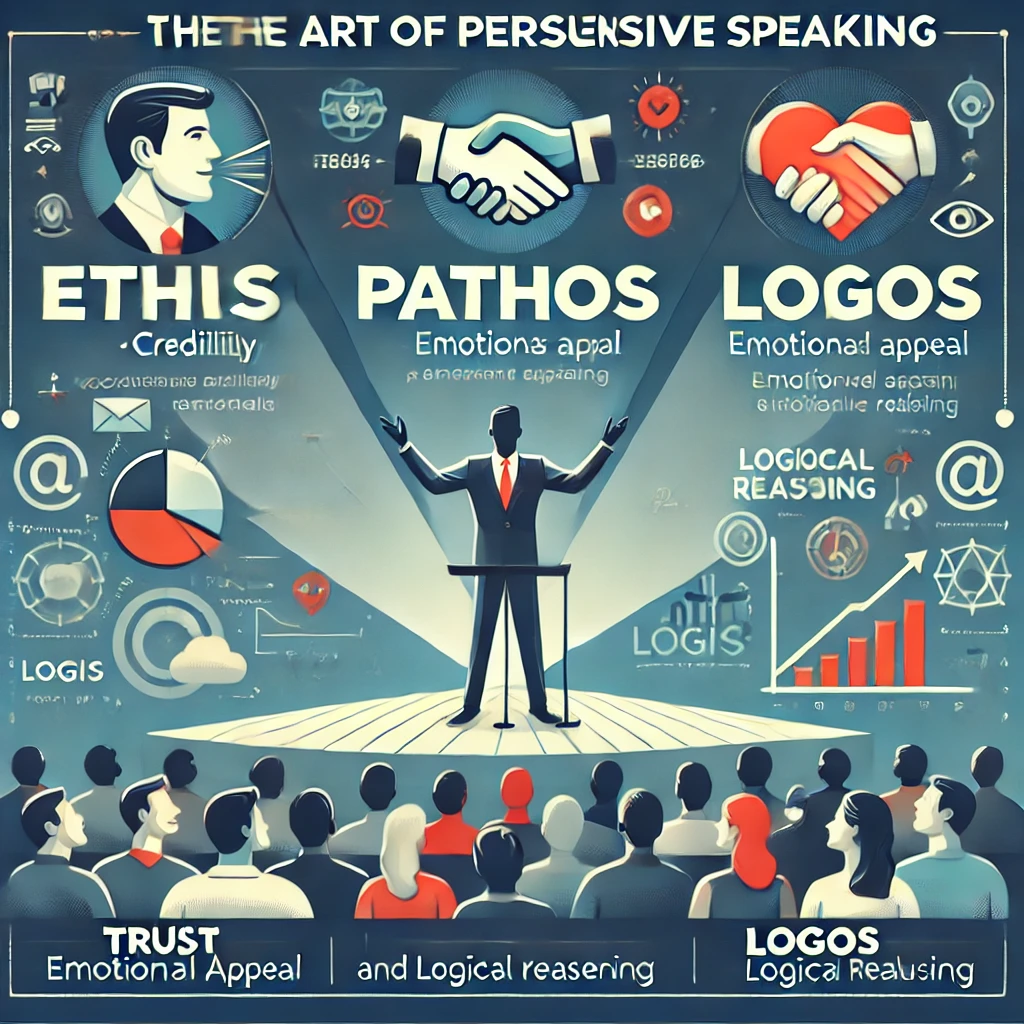Introduction
Persuasive speaking is a powerful skill that can shape opinions, inspire action, and drive change. Whether in politics, business, or everyday interactions, the ability to convince others is invaluable. Aristotle, the ancient Greek philosopher, outlined three fundamental modes of persuasion: ethos (credibility), pathos (emotional appeal), and logos (logical reasoning) (Aristotle, Rhetoric, 4th century BCE). Understanding and effectively utilizing these rhetorical elements can significantly enhance one’s ability to communicate persuasively.
This article explores each mode of persuasion, how they function in persuasive speaking, and how to balance them effectively. It also provides real-world examples and best practices to help speakers refine their persuasive skills.
1. Ethos: Establishing Credibility and Trust

Ethos refers to the speaker’s credibility or ethical appeal. It determines whether the audience perceives the speaker as trustworthy and knowledgeable (Heath, 2017). Establishing ethos is crucial because an audience is more likely to be persuaded by someone they respect and believe in.
A. Building Ethos in Persuasive Speaking
- Demonstrating Expertise – Knowledgeable speakers instill confidence in their audience. Citing credible sources, referencing experiences, and presenting facts strengthen credibility.
- Example: A doctor discussing the benefits of a new medical procedure gains credibility due to their expertise in medicine.
- Establishing Common Ground – Connecting with the audience through shared values, experiences, or beliefs enhances trust.
- Example: A politician emphasizing their local roots to relate to constituents.
- Exhibiting Moral Character – A speaker who appears honest, fair, and ethical is more likely to persuade.
- Example: Martin Luther King Jr.’s I Have a Dream speech resonates due to his moral integrity (King, 1963).
B. The Role of Authority and Reputation
People are more likely to be influenced by speakers with established authority. A well-known expert in a field has built-in ethos due to their reputation (Cialdini, 2001). This is why endorsements from credible individuals, such as scientists, celebrities, or community leaders, can be persuasive.
2. Pathos: Appealing to Emotion

Pathos engages the audience’s emotions to create a connection and drive action. Emotional appeals make arguments more memorable and impactful (Gallo, 2014).
A. Techniques for Incorporating Pathos
- Storytelling – Narratives evoke emotions and make speeches relatable.
- Example: In his TED Talk, Simon Sinek explains how companies that inspire, rather than just inform, create lasting impact (Sinek, 2009).
- Vivid Language and Imagery – Descriptive words and powerful imagery evoke feelings of joy, fear, hope, or anger.
- Example: John F. Kennedy’s inaugural address painted a vision of hope and unity (Kennedy, 1961).
- Using Emotional Triggers – Appealing to specific emotions can shape audience response.
- Fear: Used in public safety campaigns (e.g., anti-smoking ads).
- Hope: Used in motivational speeches (e.g., graduation addresses).
B. Ethical Use of Pathos
While emotional appeal is effective, it should be used ethically. Manipulating emotions without substantive arguments can be misleading (Carnegie, 1936). A balance between pathos and logos ensures credibility.
3. Logos: The Power of Logic and Reasoning

Logos appeals to logic and reason, providing evidence and structured arguments to support claims. Well-reasoned arguments enhance persuasion by making ideas more credible (Heath & Heath, 2007).
A. Key Strategies for Using Logos
- Providing Data and Evidence – Facts, statistics, and research findings support arguments.
- Example: Climate scientists use data on rising temperatures to argue for climate action.
- Structuring Arguments Logically – Presenting ideas in a clear, rational sequence improves comprehension.
- Example: The Toulmin Model (claim, evidence, warrant) is a logical framework often used in debate (Toulmin, 1958).
- Using Analogies and Examples – Comparisons help audiences understand complex topics.
- Example: Steve Jobs compared computers to a “bicycle for the mind” to illustrate their efficiency (Isaacson, 2011).
B. Avoiding Logical Fallacies
Logical fallacies undermine credibility. Common pitfalls include:
- Straw Man: Misrepresenting an argument to refute it.
- False Dilemma: Presenting only two options when more exist.
- Appeal to Authority: Assuming an argument is valid solely because an authority supports it (Kahneman, 2011).
4. Balancing Ethos, Pathos, and Logos

A. The Golden Ratio of Persuasion
The most effective persuasive speeches balance all three elements. An over-reliance on one mode weakens overall persuasion:
- Too much ethos → Comes off as arrogant or unrelatable.
- Too much pathos → Lacks substance and risks emotional manipulation.
- Too much logos → Can be dry and uninspiring.
B. Case Study: Barack Obama’s 2008 Victory Speech
Obama’s speech masterfully blended ethos (his background and credibility), pathos (hopeful vision), and logos (clear policy goals) (Obama, 2008). This balance made his message compelling and memorable.
Conclusion
Mastering persuasive speaking requires skillful integration of ethos, pathos, and logos. Establishing credibility (ethos), connecting emotionally (pathos), and presenting logical arguments (logos) ensures a well-rounded, compelling speech. By studying great orators and practicing these techniques, anyone can enhance their ability to influence audiences effectively.
References
- Aristotle. (Rhetoric, 4th century BCE).
- Carnegie, D. (How to Win Friends and Influence People, 1936).
- Cialdini, R. (Influence: The Psychology of Persuasion, 2001).
- Gallo, C. (Talk Like TED: The 9 Public-Speaking Secrets of the World’s Top Minds, 2014).
- Heath, C., & Heath, D. (Made to Stick, 2007).
- Isaacson, W. (Steve Jobs, 2011).
- Kahneman, D. (Thinking, Fast and Slow, 2011).
- King, M. L. Jr. (I Have a Dream Speech, 1963).
- Kennedy, J. F. (Inaugural Address, 1961).
- Obama, B. (Victory Speech, 2008).
- Sinek, S. (Start With Why, 2009).
- Toulmin, S. (The Uses of Argument, 1958).

